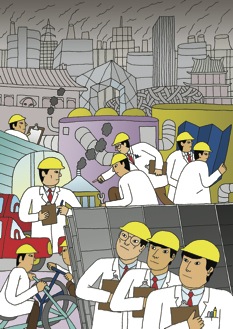 Green GiantDec 21, 2009 - Evan Osnos- The New Yorker
On March 3, 1986, four of China’s top weapons scientists—each a veteran of the missile and space programs—sent a private letter to Deng Xiaoping, the leader of the country. Their letter was a warning: Decades of relentless focus on militarization had crippled the country’s civilian scientific establishment; China must join the world’s xin jishu geming, the “new technological revolution,” they said, or it would be left behind. They called for an élite project devoted to technology ranging from biotech to space research. Deng agreed, and scribbled on the letter, “Action must be taken on this now.” This was China’s “Sputnik moment,” and the project was code-named the 863 Program, for the year and month of its birth. In the years that followed, the government pumped billions of dollars into labs and universities and enterprises, on projects ranging from cloning to underwater robots. Then, in 2001, Chinese officials abruptly expanded one program in particular: energy technology. The reasons were clear. Once the largest oil exporter in East Asia, China was now adding more than two thousand cars a day and importing millions of barrels; its energy security hinged on a flotilla of tankers stretched across distant seas. Meanwhile, China was getting nearly eighty per cent of its electricity from coal, which was rendering the air in much of the country unbreathable and hastening climate changes that could undermine China’s future stability. Rising sea levels were on pace to create more refugees in China than in any other country, even Bangladesh. In 2006, Chinese leaders redoubled their commitment to new energy technology; they boosted funding for research and set targets for installing wind turbines, solar panels, hydroelectric dams, and other renewable sources of energy that were higher than goals in the United States. China doubled its wind-power capacity that year, then doubled it again the next year, and the year after. The country had virtually no solar industry in 2003; five years later, it was manufacturing more solar cells than any other country, winning customers from foreign companies that had invented the technology in the first place. As President Hu Jintao, a political heir of Deng Xiaoping, put it in October of this year, China must “seize preëmptive opportunities in the new round of the global energy revolution.” A China born again green can be hard to imagine, especially for people who live here. After four years in Beijing, I’ve learned how to gauge the pollution before I open the curtains; by dawn on the smoggiest days, the lungs ache. The city government does not dwell on the details; its daily air-quality measurement does not even tally the tiniest particles of pollution, which are the most damaging to the respiratory system. Last year, the U.S. Embassy installed an air monitor on the roof of one of its buildings, and every hour it posts the results to a Twitter feed, with a score ranging from 1, which is the cleanest air, to 500, the dirtiest. American cities consider anything above 100 to be unhealthy. The rare times in which an American city has scored above 300 have been in the midst of forest fires. In these cases, the government puts out public-health notices warning that the air is “hazardous” and that “everyone should avoid all physical activity outdoors.” As I type this in Beijing, the Embassy’s air monitor says that today’s score is 500. One of the firms that are part of the 863 Program is Goldwind Science and Technology Company. It operates a plant and a laboratory in a cluster of high-tech companies in an outlying district of Beijing called Yizhuang, which has been trying to rebrand itself with the name E-Town. (China has been establishing high-tech clusters since the late nineteen-eighties, after scientists returned from abroad with news of Silicon Valley and Route 128.) Yizhuang was a royal hunting ground under the last emperor, but, as E-Town, it has the sweeping asphalt vistas of a suburban office park, around blocks of reflective-glass buildings, occupied by Nokia, Bosch, and other corporations. Local planning officials have embraced the vocabulary of a new era; E-Town, they say, will be a model not only of e-business but also of e-government, e-community, e-knowledge, and e-parks. When I reached Goldwind, the first thing I saw was a spirited soccer game under way on a field in the center of the campus. An artificial rock-climbing wall covered one side of the glass-and-steel research center. I met the chairman, Wu Gang, in his office on the third floor, and I asked about the sports. “We employ several coaches and music teachers,” he said. “They do training for our staff.” A pair of pushup bars rested on the carpet beside his desk. At fifty-one years old, Wu is tall, with wire-rim glasses, rumpled black hair, and the broad shoulders of a swimmer. (“I can do the butterfly,” he said.) For fun, he sings Peking opera. Wu said that he had not been a robust child: “My education was very serious. Just learning, learning, learning. I wanted to jump out of that!”
|
Email this page to a friend
If you speak another language fluently and you liked this page, make
a contribution by translating
it! For additional translations check out FreeTranslation.com
(Voor vertaling van Engels tot Nederlands)
(For oversettelse fra Engelsk til Norsk)
(Для дополнительных
переводов проверяют
FreeTranslation.com )


